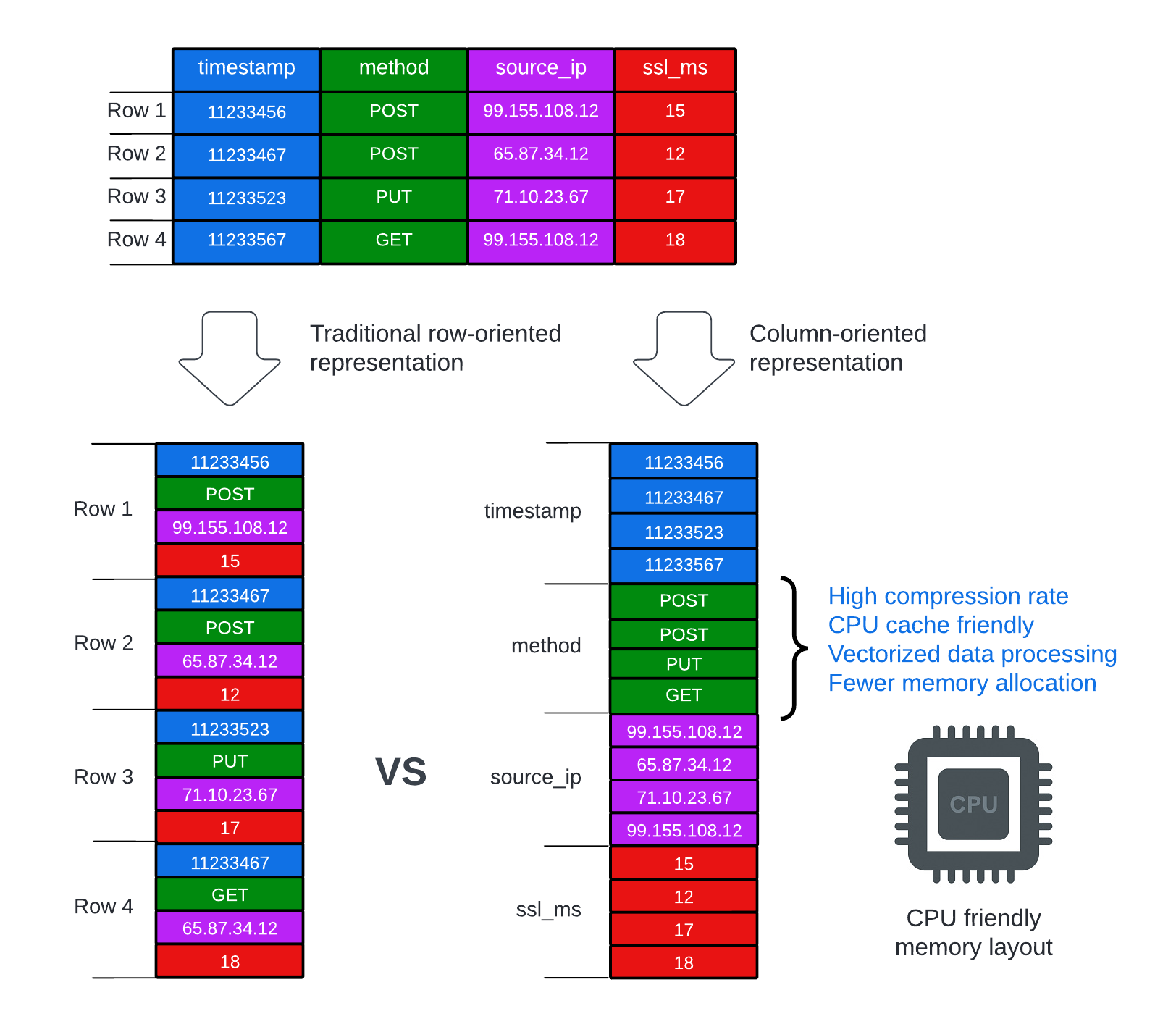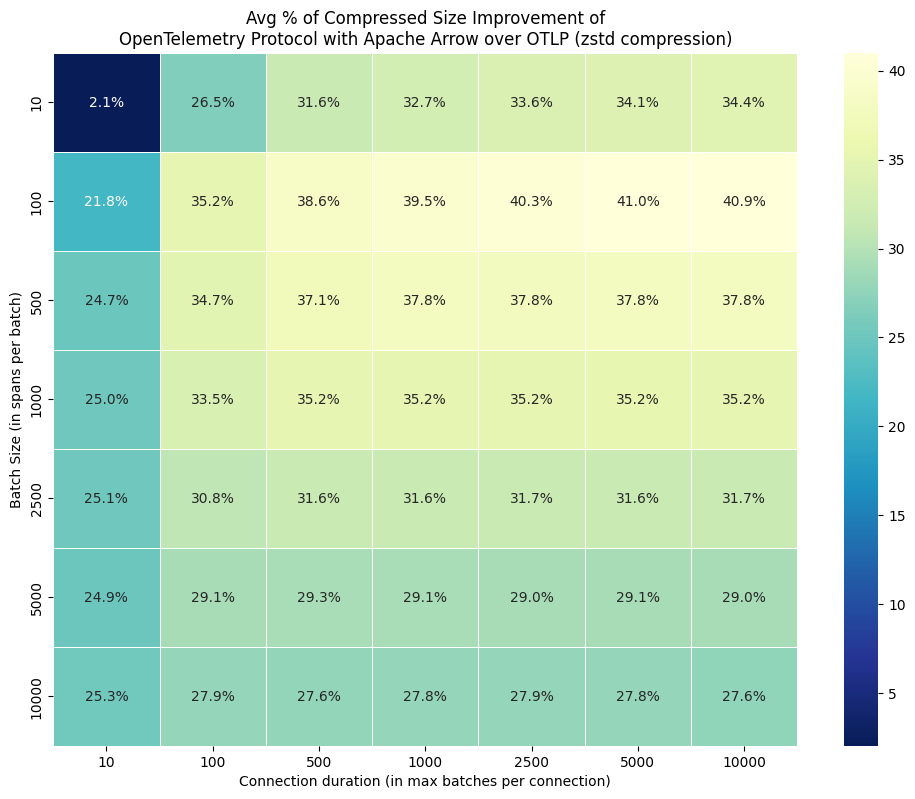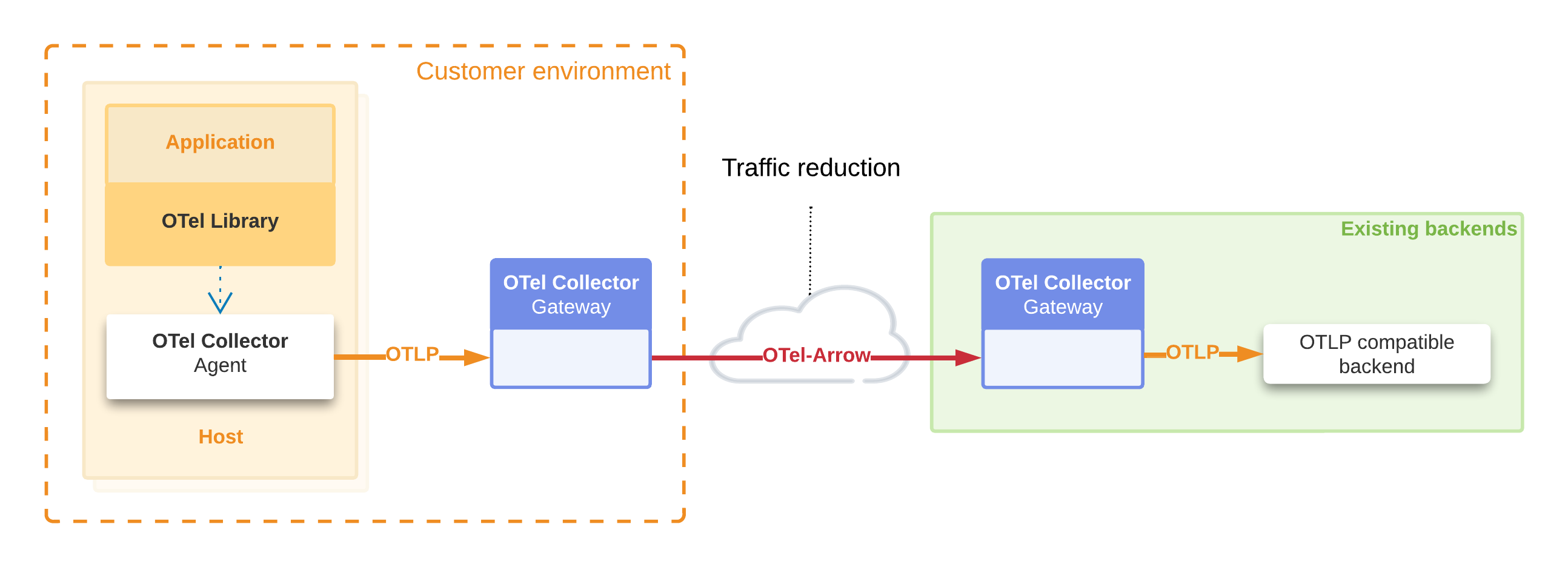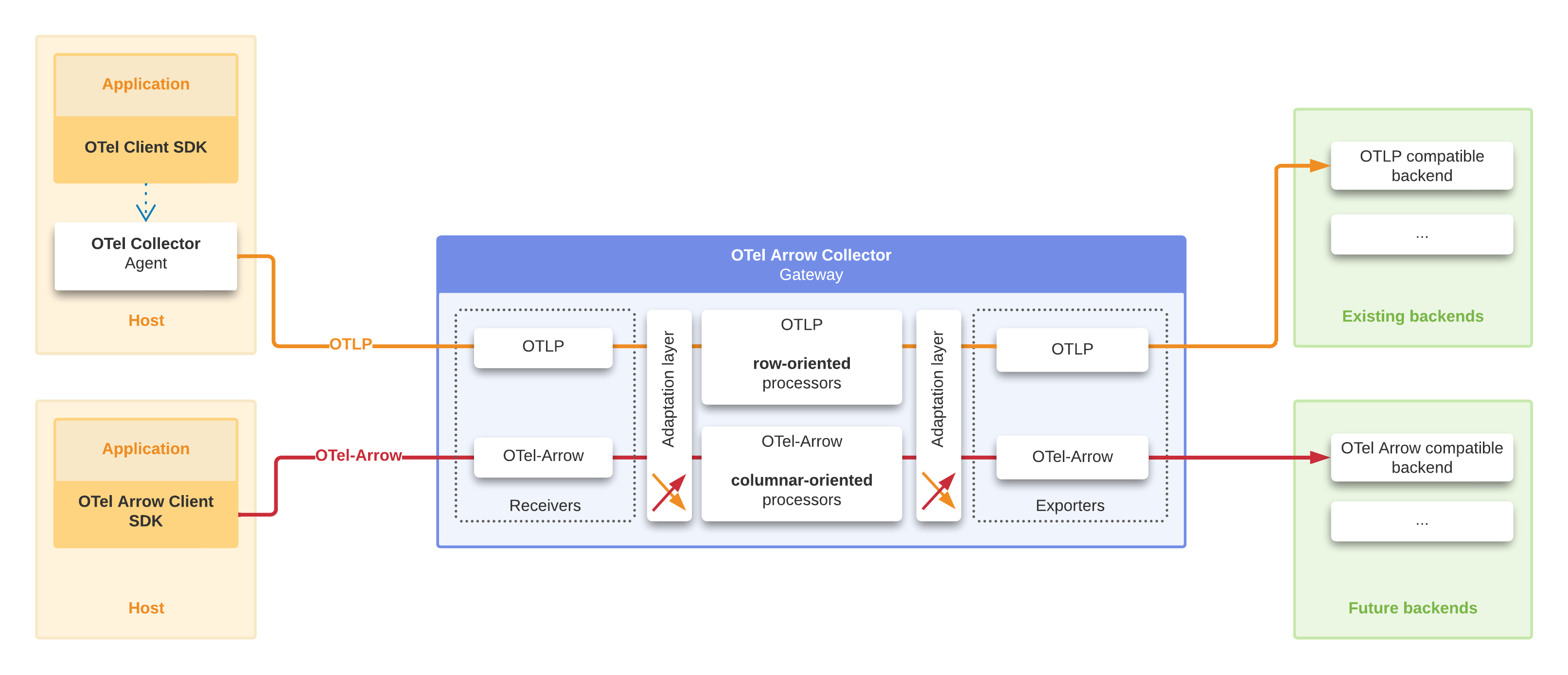Achieve a 10x Reduction in Telemetry Traffic Using OpenTelemetry Protocol with Apache Arrow
We are thrilled to unveil the OpenTelemetry Protocol with Apache Arrow, which is based on Apache Arrow, a columnar-oriented memory format used for developing analytics applications. This integration facilitates a reduction in telemetry data traffic by a factor of 10 after compression, offering a 40% improvement over the best existing OpenTelemetry Protocol (OTLP) configurations with Zstandard (zstd) compression enabled. As a result, this new protocol emerges as an optimal choice for transporting telemetry data over the internet. We are also excited to announce the release of a new pair of receiver/exporter in the opentelemetry-collector-contrib repository that supports this protocol. This protocol, designed to complement the OTLP protocol in situations with substantial telemetry data volumes, has been under discussion and development for two years. It represents a collaborative effort between F5, ServiceNow Cloud Observability , and numerous technical leaders from the OpenTelemetry community (see donation). The compression benefits are significant, demonstrating a 40% improvement compression efficiency for the majority of workloads and even greater enhancements for workloads that contain multivariate metrics, which share attributes. One of the highlights of the OpenTelemetry Protocol with Apache Arrow integration is its seamless adaptability. In a typical deployment, incorporating OpenTelemetry Protocol with Apache Arrow doesn’t necessitate any substantial changes. Users simply need to redeploy a new version of the OpenTelemetry Collector with a slightly tweaked configuration.
This new protocol will serve as the cornerstone for future advancements in telemetry data processing and will generally foster enhanced integration with modern telemetry backends.
Why a new protocol?
The growth in telemetry data is undeniable and rapid. This surge is attributed to several factors:
- Proliferation of devices and sensors
- Shift from monolithic application deployment to more granular forms like containers and serverless functions
- Increasing reliance on data-driven and AI-driven technologies
As telemetry data becomes increasingly distributed, workloads become location-agnostic, spanning data centers, clouds, and the edge. This distribution amplifies the urgency to optimize telemetry transport across the internet. As the ecosystem transforms, the imperative to optimize and align the components of a telemetry pipeline end-to-end becomes more pronounced.
Enter the OpenTelemetry Protocol with Apache Arrow, a pivotal solution crafted to meet this growing demand.

Historically, when telemetry data volumes were moderate, their wire representation didn’t pose significant concerns. Such data was typically encapsulated as structured objects using diverse serialization frameworks. Until recently, OpenTelemetry primarily supported either JSON or, more commonly, a protobuf-based binary format for metrics, logs, and traces. This choice, particularly with protobuf, offers a good balance between simplicity, data representation efficiency, and performance, especially when transmitting low to medium volumes of complex telemetry objects across the network.
On the backend, however, this data is typically stored in a columnar format to optimize compression ratio, data retrieval, and processing efficiency (see fig 1 to compare row vs columnar data representation). Transitioning to an end-to-end columnar representation throughout the pipeline streamlines the interface between telemetry transport and backend. Additionally, it reduces the network bandwidth required for telemetry data transmission. The OpenTelemetry Protocol with Apache Arrow utilizes this columnar representation for metrics, logs, and traces, leading to significant savings in network expenses.
 Fig 1: Memory representations: row vs columnar data.
Fig 1: Memory representations: row vs columnar data.
To further optimize the transmission of batches of OTel entities, this new protocol uses gRPC streams to efficiently leverage dictionary encoding. Much of the textual data between batches is redundant; attribute names and values are frequently repeated. Apache Arrow supports dictionary encoding and a stream-oriented protocol allows us to send only the deltas of those dictionaries between consecutive batches. These techniques enhance the protocol’s compressibility.
Another area of inefficiency is the way the OTel data model handles multivariate metrics. Currently, there’s an absence of a streamlined approach to report a batch of metrics with shared attributes without redundantly replicating these attributes. In specific scenarios, this redundancy places an undue strain on both the network bandwidth and overall resource utilization. Our newly designed protocol addresses this by offering an enhanced representation of multivariate metrics. In certain scenarios, we’ve seen compression improvements of up to 7x compared to OTLP, all without modifications on the client side. Future client SDKs could be implemented to seamlessly expose this enhancement, potentially leading to even better results for applications.
The following heatmap represents, for different combinations of batch sizes and connection durations (expressed as the number of batches per stream), the additional percentage of compression gain between this new protocol and OTLP, both compressed with zstd. The data used here comes from a traffic of spans captured in a production environment. The gains are substantial in most cases. It is even interesting to note that these gains compared to OTLP+zstd are more significant for moderate-sized batches (e.g., 100 and 1000 spans per batch), which makes this protocol also interesting for scenarios where the additional latency introduced by batching must be minimized. There is hardly any scenario where micro-batches (e.g., 10 spans per batch) make the overhead of the Arrow schema prohibitive, and the advantage of a columnar representation becomes negligible. In other cases, this initial overhead is very quickly offset after just the first few batches. The columnar organization also lends itself better to compression. For very large batch sizes, zstd does an excellent job as long as the compression window is sufficiently large, but even in this case, the new protocol remains superior. As previously mentioned, these compression gains can be higher for traffic predominantly containing multivariate metrics.

The advancements don’t end there. In a subsequent phase of this project, we aim to leverage the columnar layout to significantly enhance data processing speeds within an expanded OpenTelemetry Collector architecture that natively supports a new Arrow-based pipeline. Based on our proof of concept, we anticipate at least an order of magnitude improvement in data processing speed with this updated collector.
These different sources of inefficiency and misalignment are the rationale behind our support for the new OpenTelemetry Protocol with Apache Arrow as an alternative to the existing OpenTelemetry Protocol. Our decision to leverage the well known Apache Arrow project for this new columnar representation offers numerous advantages. Apache Arrow is very efficient and well adopted in the database, data stream processing spaces. Its rich ecosystem boasts a range of powerful libraries and tools, from Parquet bridges to query engines such as DataFusion. Such resources can expedite the introduction of innovative features, aligning OpenTelemetry more closely with modern data pipelines that are increasingly pivoting towards Apache Arrow.
A specification for this protocol (OTEP 0156) can be found here. A reference implementation of the encoding/decoding function can be accessed here.
How can I leverage the OpenTelemetry Protocol with Apache Arrow in my deployment?
In the initial phase of this project, our primary goal is to optimize communication between two collectors. This is commonly observed in setups where telemetry traffic is funneled through one or multiple collectors before being relayed across the internet for backend processing. Given the increased complexity of the OpenTelemetry Protocol with Apache Arrow compared to the original OTLP, its containment between two collectors offers an easier target to hit and reduces potential disruptions to the broader ecosystem. Existing client SDKs, processors, receivers and exporters can continue to work seamlessly. Only the exporter and the receiver between the two collectors need to be reconfigured. The immediate benefit will be a reduction in network bandwidth, leading to direct savings on network costs (up to 7x for metrics, 2x for logs, and traces). For a comprehensive breakdown of this deployment, click here Building the collector.

As is often the case, there isn’t a one-size-fits-all solution. Deployments with limited resources or those generating minimal telemetry should stick with the standard collector based on OTLP. Moreover, OpenTelemetry Protocol with Apache Arrow necessitates the support of bi-directional gRPC streams and some degree of batching to fully benefit from the columnar representation. This can make the solution unsuitable in certain specific scenarios. It’s also worth noting that, during this phase of the project, a slight increase in CPU and memory usage is expected in the collector. This is due to the overhead of automatically translating OTLP objects to OpenTelemetry Protocol with Apache Arrow objects. However, this overhead will be completely eliminated in the subsequent phase of the project.
We value our users a lot so a validation framework has been developed to reduce errors and mitigate the risk of regression. We’ve utilized a telemetry data generator to test encoding and decoding processes, specifically converting between OTLP and OpenTelemetry Protocol with Apache Arrow, and vice versa. Additionally, a flexible comparator has been put in place to semantically compare the original OTLP request, produced by the generator, with the resulting OTLP request after the encoding/decoding process. This approach has enabled us to address numerous edge cases and rectify several critical bugs. To pinpoint the origins of potential issues, our evaluation took place at two distinct levels: firstly, a foundational one where we interacted directly with the core encoding/decoding mechanisms, sidestepping both collector integration and network communications; and secondly, at the collector level, providing a thorough review of the entire pipeline, which encompassed network interactions.
To strengthen the decoding methods against ill-formed (whether intentional or not) OpenTelemetry Protocol with Apache Arrow messages, we deliberately introduced anomalies into the OpenTelemetry Protocol with Apache Arrow message prior to decoding. Our objective was to ensure the decoding methods would respond with an error message, rather than crash, when encountering invalid inputs.
Beyond these automated procedures, ServiceNow Cloud Observability took further steps by deploying the experimental collector across various staging environments. This was done to assess both the collector’s behavior and the protocol’s resilience when confronted with real traffic. Not only did these deployments result in enhancements to our automated validation framework, but they also substantiated our benchmark findings.
While we’ve diligently worked to identify and address regressions and issues, we recognize the complex and varied nature of real-world scenarios. Thus, we encourage the community to evaluate this new protocol across diverse deployment situations and traffic loads, starting with the least sensitive environments. Your deployments and feedback will assist us in further strengthening this project.
To facilitate this testing phase, we have also improved the file exporter to save and anonymize the data in a compressed format. We have developed tools to enable the analysis and replay of this anonymized traffic in order to identify either bugs or sources of inefficiency. This approach recently played an important role in improving the logic that defines the best Arrow schemas to use for a given traffic. During an experiment in a production environment, we noticed a degradation in the compression rate after one million spans. Upon analysis, we were able to identify the source of the problem and adjust the protocol to ensure that this type of degradation is no longer observed (see this PR).
Next
In the future, we plan to focus on fully integrating OpenTelemetry Protocol with Apache Arrow throughout the ecosystem. The proposed developments are as follows (not necessarily in order of priority):
- Development of Schema-First Client SDKs generator with native support for OpenTelemetry Protocol with Apache Arrow and multivariate metrics: Aimed at optimizing scenarios with high telemetry producers.
- Introduction of a new pipeline type in the Collector: This will introduce a new generation of receiver, processor, and exporter, each designed specifically for consuming and/or producing OpenTelemetry Protocol with Apache Arrow messages. By streamlining communication between components, we expect to enhance data processing efficiency. Significant acceleration is anticipated as conversions to and from OTLP, as well as the serialization and deserialization of telemetry batches, will be bypassed.
- Leveraging SIMD-based data processing engines from the Apache Arrow ecosystem: This will further accelerate telemetry data processing and expand the range of data processing capabilities.
- Consideration of adding Parquet exporters: Made possible by the existing bridge between Apache Arrow and Apache Parquet.
- The broader community is also anticipated to develop more streamlined exporters to better integrate with specific telemetry backends.

Conclusion
We’re excited to witness the testing and benchmarking of this new protocol by the community. In our view, this represents a significant milestone for the OpenTelemetry community, with even more thrilling developments on the horizon.
For those keen on delving into the intricacies of integrating OpenTelemetry with Apache Arrow, we recommend reading these two articles featured on the Apache Arrow Blog [1, 2]. You will find a presentation of the various approaches to effectively represent the hierarchical and dynamic objects that are the OTel metrics, logs, and traces.
We would like to express our gratitude to our employers, F5 and ServiceNow Cloud Observability, for allowing us to spearhead and execute this project. Additionally, our thanks extend to the numerous OTel technical leaders for their invaluable assistance.
Links
- OpenTelemetry Protocol with Apache Arrow Specification - OTEP 0156
- OpenTelemetry Protocol with Apache Arrow (encoder/decoder) repository.
- Receiver documentation.
- Exporter documentation.